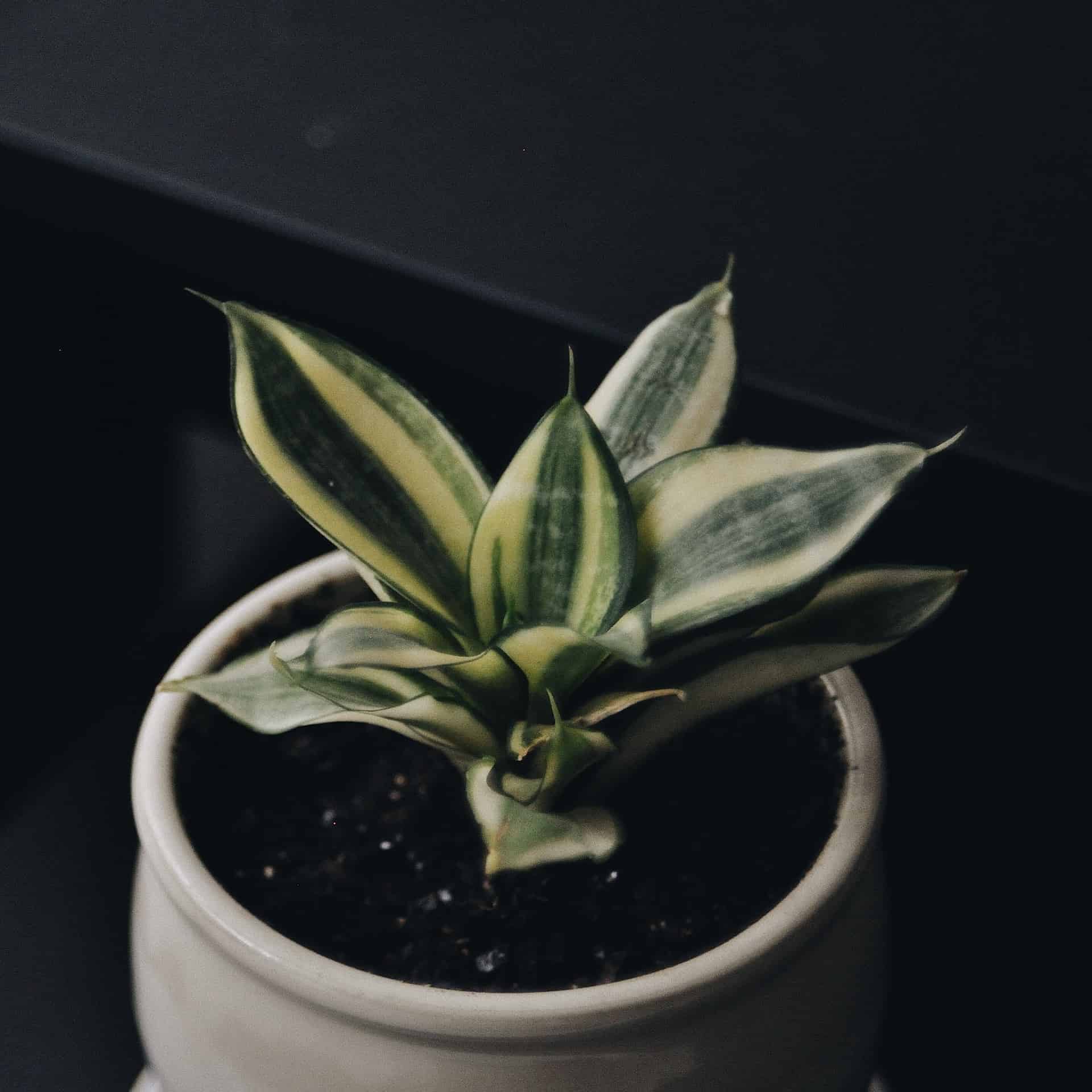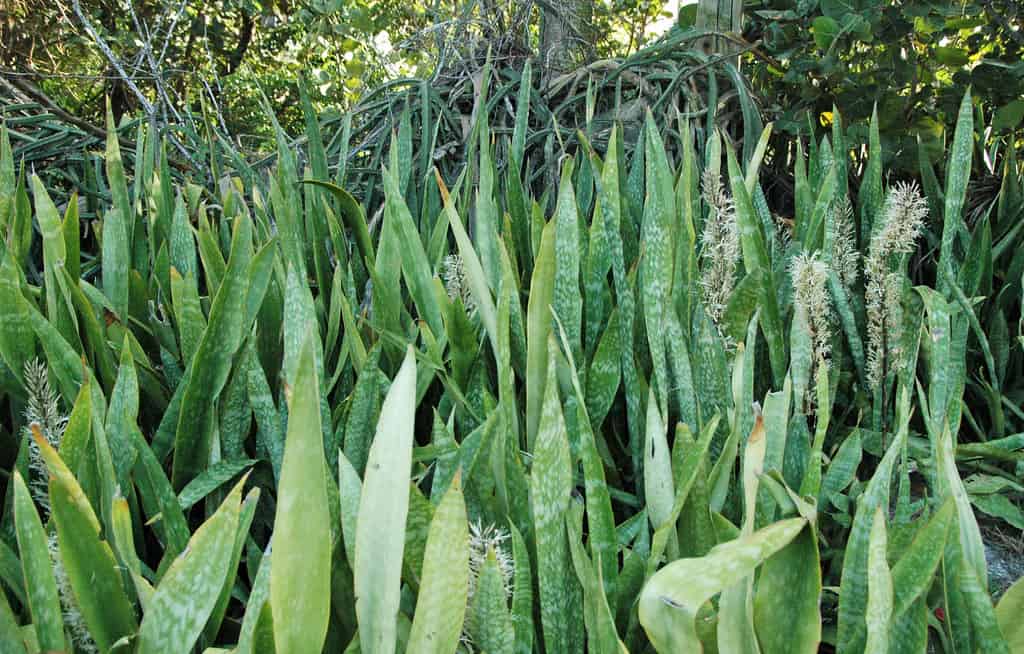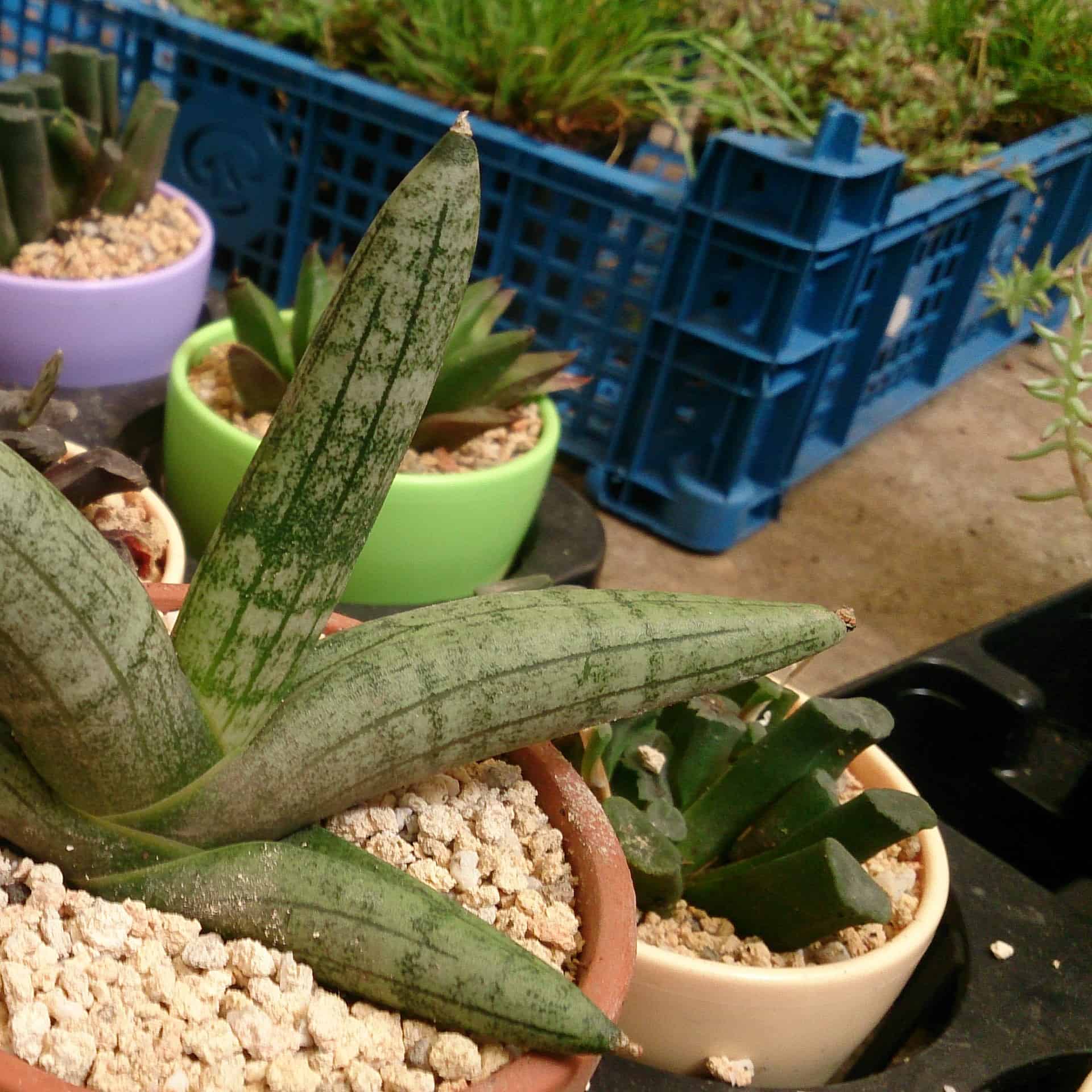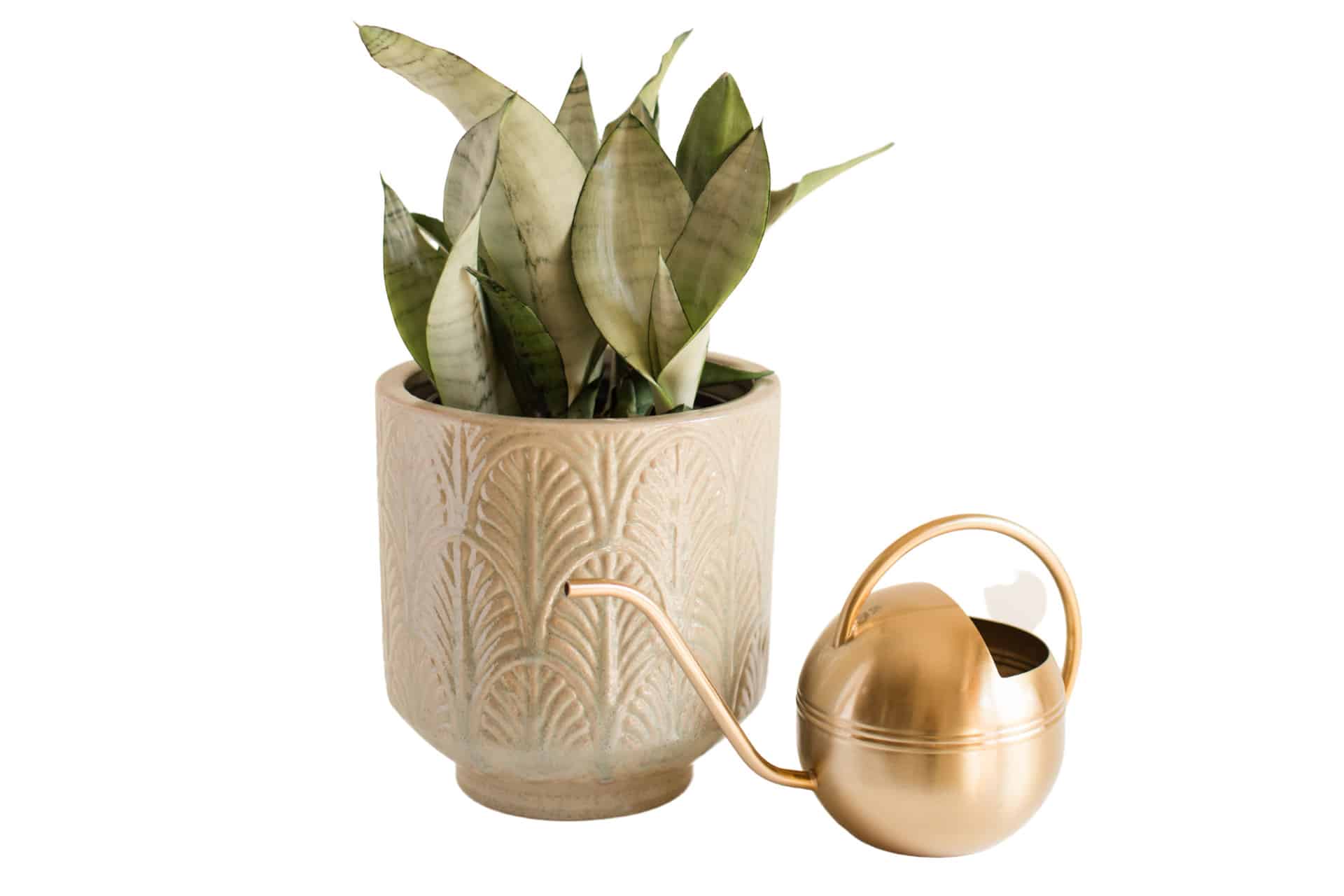No products in the cart.
Has curiosity made you want to know more about snake plants? Then this article on the Sansevieria plant is sure to be interesting. Many refer to the plant as the mother-in-law’s tongue or the snake plant.
It can grow up to six feet tall in the wild and thrives in an indoor plant collection. Hence, it makes for an ideal houseplant for interior design or landscaping.
35 Beautiful Sansevieria Varieties
According to some gardeners and nursery centers, Snake plants are still profitable due to their structural design for landscapes, low maintenance, low light tolerance, and easy nature.
You will love to add these snake plant varieties to your indoor plant collection.
Sansevieria trifasciata

The better-known snake plant is the mother-in-law’s tongue originating from West Africa. The Sansevieria trifasciata grows from rhizomes with creeping sword-shaped leaves with lanceolate margins.
The foliage grows grass green and has light green horizontal bands. The leaves can grow up to 1.3 feet. A popular cultivar is the Laurentii, with bright yellow margins and stripes on the leaf edges. Some other Sansevieria varieties in this species are the Hahnii, with vivid colors and rosette pattern funnel-shaped leaves.
Meanwhile, the Golden Flame has gorgeous golden-yellow stripes. Growing snake plants indoors is not difficult, especially regarding this cultivar. Ensure it has well-drained soil with indirect sunlight and good drainage.
You must agree the distinctive appearance of the snakeskin-like pattern makes it look like a snake.
Sansevieria ‘Black Gold’
For a unique plant, nothing comes close to the Black Gold variety to add some elegance to the home. The Sansevieria plant has dark green leaves with golden stripes that run down the center.
Black Gold has thick leaves and is a tough plant growing up to two feet long. The slow-growing plant is native to Africa and India and is drought-resistant. Hence, it can handle some neglect. Thus, it can thrive in indirect light with its pointy leaves.
So, add the Black Gold to your indoor gardens, as those fleshy leaves store enough water but do not enjoy waterlogged soil, as it can lead to root rot.
Sansevieria ‘Futura Robusta’

Here, we have a snake plant closely related to the Agave plant. The Futura Robusta has thick, fleshy leaves in a green color with yellow stripes that run down the center.
The foliage grows with a rosette pattern and can reach up to three feet long. In summer, it produces small white flowers. It is also very resistant to disease and pests.
The flowers grow on a single stalk, but the chance of it blooming indoors rarely happens.
Sansevieria trifasciata ‘Twist’
When grown indoors, the Twist Sansevieria will make a statement with the pointy leaves. It resembles the mother-in-law’s tongue but is a dwarf snake plant with green leaves and white stripes. The leaves reach up to two feet long and one foot wide. It also blooms small white flowers.
You can grow this snake plant outdoors or indoors.
Sansevieria’ Cylindrica’

The Sansevieria cylindrica is a unique snake plant belonging to the Asparagaceae family. The plant’s natural habitat is South Africa, growing in sandy to dry habitats.
Compared to the sword-shaped leaves of other Sansevieria varieties, it grows cylindrical green leaves and has dark brown tips with black bands. The leaves can reach up to two feet long and is an inch in diameter.
Like the other snake plants, it blooms a small white flower on a stalk stretching above the leaves. The plant is not frost-tolerant and is best grown indoors.
Sansevieria ‘Laurentii’
Another Sansevieria variety native to West Africa is the Laurentii. It has long, slender green leaves with yellow stripes along the center. The arranged leaves form a rosette pattern reaching up to three feet long. It also produces a small white flower in early summer.
Sansevieria ‘Golden Hahnii’

The plant is closely related to the Sansevieria trifasciata and has thick, fleshy, light green leaves with yellow stripes. It also forms a rosette reaching up to one foot in length. In summer, you see small white flowers, and it thrives outside and indoors. If you have a busy schedule, this snake plant is what you need.
It can handle bright light with moderate watering.
Sansevieria’ Moonshine’
Another unique snake plant is the Moonshine, which is a variegated cultivar. The snake plant has long, thin leaves with a yellow-green coloration with dark green stripes down the center. It is a dwarf cultivar reaching heights of two to three feet.
Still, it can spread outwards, forming an unusual clump and an ideal indoor plant.
Sansevieria Masoniana

Another common name for this snake plant is Mason Congo. The plants are native to West Africa and named after a British botanist Frederick Mason Bailey.
He was the plant founder when he traveled to Nigeria at the beginning of the 20th century. The thick leaves grow up to three feet tall and two feet wide with dark green hues and white stripes along the length of the leaf.
It blooms small flowers during summertime. The leaves grow in sword shape with pointy tips.
Sansevieria’ Bantel’s Sensation’
Another unique member of the Sansevieria family native to West Africa is the Bantel’s Sensation. The snake plant has long, slender leaves variegated in green, yellow, and white stripes with a wavy edge. It is not a slow grower but the opposite, reaching three feet tall.
The snake plant blooms clusters of small white blooms followed by berries.
Sansevieria kirkii
 Sansevieria kirkii @flickr
Sansevieria kirkii @flickr
The Star Sansevieria or Sansevieria kirkii is native to Kenya and Tanzania. The name honors Thomas Kirk, a British botanist who found the plant in the 19th century. This is not a dwarf cultivar and can reach up to three feet tall and two feet wide.
It has dense leaves that are fleshy, dark green color, and white stripes.
Sansevieria gracilis
Now, a completely different snake plant with no pointed leaves is the Sansevieria gracilis. It has thin, narrow green leaves forming rosettes and is native to East Africa. On the leaves are yellow stripes reaching up to three feet tall.
It blooms with small white flowers and is an evergreen succulent plant to add to any collection.
Sansevieria ‘Desert’
For a flowering succulent snake plant native to the African deserts, you will love the Sansevieria Desert. The long, slender leaves have a green color with white stripes. The flowers range from white to purple, with markings growing in clusters. It does very well in full sun or even grows in partial shade.
It thrives on minimal care and adds a touch of beauty to any landscape.
Sansevieria patens

The Sansevieria patens are native to tropical Africa and have strap-like dark green foliage. It has light green horizontal bands running along the length of the foliage. The leaves grow three feet long and 2.4 inches wide as the plant matures.
The intricate pattern stands out, and when in bloom, you notice tubular flowers growing on clusters on the tip of stalks.
Sansevieria parva ‘Kenya Hyacinth’
The Parva is another type of snake plant native to Kenya. The plant received its name from Nairobi, a Kenyan city, where the British botanist Ethelbert Blatter first found it. It can grow up to two feet tall and one foot wide.
The thin leaves are similar to succulents with green and white stripes. It blooms small flowers in summer.
Sansevieria fischeri

The long, thin, variegated leaves categorize the snake plants in green with white stripes. It is another native plant to Kenya, growing up to 8 inches long. These tiny plants produce baby plants known as offsets to propagate.
So, you can easily remove them from the mother plant to create new plants.
Sansevieria Ballyi
This Sansevieria plant is also native to Kenya and is a perennial plant growing up to three feet tall. The dark green leaves stand out with their wavy edges. It is covered in small white spots, making it look unique. The flowers are white, with a bell-shaped form blooming in summer.
Sansevieria ehrenbergii
 Sansevieria ehrenbergii @flickr
Sansevieria ehrenbergii @flickr
You can easily recognize the Blue Sansevieria with its bluish-green leaves. It has stiff sword-like leaves that grow up to five feet long with a rosette pattern and pointy tips. Compared to other types of snake plants, this is a very slow-growing plant indoors. Yet, in summer, you see white blooms with a sweet fragrance attracting bees.
Still, if you grow them outside, protect them from frost.
Sansevieria Eillensis Chahin
The plant is also a snake or the mother-in-law’s tongue native to Somalia. It has small, thick foliage that resembles that of a snake. The dark green leaves have pale yellow stripes up to five inches long. It seldom blooms flowers but grows on stalks reaching 12 inches long.
It is a tough plant needing little care but protects them from frost.
Sansevieria canaliculata

These snake plants are native to Madagascar, growing in a rosette form and reaching up to two feet tall. The dark green leaves look gorgeous with the white stripes and tiny white blossoms in summer to late fall.
Sansevieria Cleopatra
The Cleopatra has gold-colored foliage with very dark green margins and small plants remaining small at one foot tall. The dwarf snake plant is native to Africa and prefers warm to humid climates.
Sansevieria zeylanica

The native home of this unique plant is Sri Lanka, where it grows in arid yet sandy to rocky soil. The cultivar can reach up to two feet tall and has green-white leaves that feel like leather. You see speckles with a skinny green line and a wavy appearance on the leaf surface.
Even the root system grows in a flat pattern.
Sansevieria eilensis
For growing snake plants indoors, the Sansevieria eilensis remains a popular choice. The sword-shaped leaves stand upright and stiff, growing up to 2 feet tall. It has dark green leaves with a light green vertical line.
These strips can be curved or straight, depending on your variety. Compared to the other cultivars, it grows slowly, adding one new leaf in a year.
Eillensis Chahin
The Sansevieria Eillensis Chanins is also a snake plant native to Somalia, with small, thick leaves resembling snakes. You see pale yellow-green leaves with stripes growing up to 5 inches long. It does not bloom often, but when it does, you see flowers on stalks reaching up to one foot long.
It does not need much care, but you do need to keep them protected from frost.
Sansevieria bacularis

Another popular houseplant with an attractive appearance is the snake plant. It has long, thin, spiral-patterned leaves. You also see variegated foliage in multiple colors reaching up to two feet tall with white flowers when it blooms.
Depending on the variation, it can have leaves with a gray-green appearance or even yellow.
Sansevieria burmanica
These snake plants native to Burma grow up to two feet tall, storing water in the leaves. The succulent has dark green with light green stripes running vertically. The flowers grow in clusters and are a unique addition to any living space.
Sansevieria Whitney
For compact snake plants that look as if they have snakelike skin, choose the Whitney, which grows up to one foot tall. The plant has dark green leaves in sword-shaped form with sharp tips and leathery. The plant will surely make a statement in the home.
Sansevieria francisii
 Sansevieria francisii @flickr
Sansevieria francisii @flickr
The plant is native to Madagascar and Asia, growing up to two feet tall and three feet wide. The thick sword-shaped foliage is blue-green, similar to the blue sansevieria with cream or white lines.
The blooms are small white-green during summertime. The succulent stores enough water in the leaves to handle drought better. So, if you live in arid areas, these snake plants must be on your list to grow indoors and outside.
Sansevieria liberica
These Sansevieria varieties are native to Central and West Africa, with belt-shaped leatherlike lanceolate leaves with more upright growth. The leaves can reach up to 3 feet with light green streaks on the dark green leaves. As these plants mature, the foliage becomes white and pointed with red-brown margins surrounded by panicle flowers.
The stem can reach up to two feet tall.
Sansevieria hyacinthoides
 Sansevieria hyacinthoides @flickr
Sansevieria hyacinthoides @flickr
The African spear is another variety of snake plants native to South Africa—the foliage you see displayed as long spears growing up to four feet long. The leaves are green with brown-black stripes with a rosette form.
It is another plant that grows slowly, and once it matures, it can thrive in poor growing conditions. The unique about the Sansevieria hyacinthoides is the flower. The plant blooms trumpet-shaped flowers in white with purple streaks.
The flower has a fragrance and blooms in summer and fall.
Sansevieria Jade Marginata
Another snake plant native to Western Africa is the Jade Marginata, which has dark green foliage and white margins. The fleshy foliage grows up to ten inches long and blooms in summer with small, fragrant flowers.
Sansevieria Whale Fin
 Sansevieria whale fin @flickr
Sansevieria whale fin @flickr
The Whale Fin differs with its paddle-like leaves regarding the types of snake plants. The plant prefers standing in low to bright indirect light, and the dark green leaves are mottled with creamy yellow streaks.
When the plant matures, it reaches up to two feet high and three feet wide. These snake plants are slow-growing and do not need repotting often. It is also non-toxic to humans and pets, making it a safe home choice.
Sansevieria Coppertone
The variegated snake plant has gorgeous foliage in a mix of yellow and green leaves that are shorter and thicker than most other Sansevieria plants. It forms a compact rosette and is an excellent choice for small spaces. While it is not a drought-tolerant species, it can handle some neglect.
Sansevieria ehrenbergii ‘Banana’
As the name implies, the Banana is another hardy plant from the snake plant varieties. The thick, fleshy leaves resemble a banana tree with a curved shape. The foliage covered in white spots gives it a unique look.
The leaves grow large, up to two feet long, and are an excellent choice where no foot traffic is present.
Cylindrica Boncel

The cylindrical boncel is a snake plant in Angola with long, slender, dark green leaves with white bands in a rosette form. It is a dwarf variety growing up to one foot and is ideal for small spaces. It is drought resistant, thriving in full sun to shade, needing little water.
Caring For Your Snake Plant
Caring for your snake plants is not difficult as they are tolerant of some neglect. These plants can stand in low light, poor soil, and dry conditions. Still, provided with the correct growing conditions, they produce more vibrant leaves.
Fertilizing Snake Plants
You can fertilize your snake plants every four weeks in spring and summer. The best feed is a water-soluble one diluted to a half-strength.
The Best Light For Those Dark Green Leaves

While snake plants can tolerate low light, they do their best in bright, indirect light. Low light will make your plant grow slower, and if you notice the leaves turning yellow, your houseplant needs more light.
Snake plants do best in bright, indirect sunlight. They can tolerate low light levels but grow slower in these conditions. If you notice that the leaves are turning yellow, this is a sign that the plant is not getting enough light. Move it to a brighter location.
Temperature and Humidity
Snake plants can thrive in different temperatures and humidity and can survive in temperatures ranging between 50° F (10° C) to 90° F (32° C).
Watering All Types of Snake Plants

Only water you plant when the top inch of the soil is dry, and allow the excess water to drain from the container. We recommend throwing out the water in the catch saucer as it can lead to root rot.
Pruning Snake Plants
When you notice damaged or dead leaves to brown tips, it is the only time you need to prune your plant.
Repotting Snake Plants

The Sansevieria varieties do not grow too fast and will need repotting every three years when you notice the roots growing out of the pot. Choose a bigger container and fill it with well-drained soil.
Propagating Snake Plants
The best propagating methods are division or leaf cuttings. You can cut a one-inch piece of leaf for leaf cuttings and allow it to callus for a few days. Then, plant it in well-drained soil and keep it moist until new plants emerge in six weeks.
You must remove your plant from the pot to divide the roots into smaller sections for division.
Overwintering Sansevierias
Snake plants do not do well in cold temperatures, and growing snake plants indoors is best, especially in areas prone to snow and frost.
Pests and Diseases
Like most houseplants, your snake plant can become susceptible to scale, mealybugs, and spider mites. You can control these insects using neem oil or insecticidal soap. If our plant has leaf drops, it can be from too little light or overwatering. While brown foliage results from too much sunlight or fertilizer burn.
Final Thought
The Sansevieria plants are great options for a houseplant that needs minimal care. They need moderate light, and their versatile appearance makes them attractive to grow in any living space. Some even take up little space to stand in the office or at home.
So, buying snake plants can add a modern touch to your living space.
Whether you want to buy, sell, or simply reach out to other plant enthusiasts, Plantly is the right place to be!


